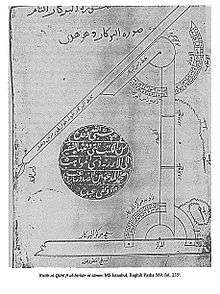Ibn al-Shatir
| Ibn al-Shatir | |
|---|---|
| Born | 1304 |
| Died | 1375 (aged 71) |
| Occupation | Astronomer |
Ibn al-Shatir or Ibn ash-Shatir (Arabic: ابن الشاطر; 1304–1375) was an Arab astronomer. He worked as muwaqqit (موقت, religious timekeeper) in the Umayyad Mosque in Damascus and constructed a magnificent sundial for its minaret in 1371/72.
His most important astronomical treatise was kitab nihayat al-sul fi tashih al-usul ("The Final Quest Concerning the Rectification of Principles"). In it he drastically reformed the Ptolemaic models of the Sun, Moon and planets, eliminating the eccentric and equant by introducing extra epicycles.
Although his system was firmly geocentric (he had eliminated the Ptolemaic eccentrics), the mathematical details of his system were identical to those in Copernicus's De revolutionibus.[1] It is unknown whether Copernicus read ibn al-Shatir.
See also

Notes
References
- Fernini, Ilias. A Bibliography of Scholars in Medieval Islam. Abu Dhabi (UAE) Cultural Foundation, 1998
- Kennedy, Edward S. "Late Medieval Planetary Theory." Isis 57 (1966):365-378.
- Kennedy, Edward S. and Ghanem, Imad. The Life and Work of Ibn al-Shatir, an Arab Astronomer of the Fourteenth Century. Aleppo: History of Arabic Science Institute, University of Aleppo, 1976.
- Roberts, Victor. "The Solar and Lunar Theory of Ibn ash-Shatir: A Pre-Copernican Copernican Model". Isis, 48(1957):428-432.
- Roberts, Victor and Edward S. Kennedy. "The Planetary Theory of Ibn al-Shatir". Isis, 50(1959):227-235.
- Saliba, George. "Theory and Observation in Islamic Astronomy: The Work of Ibn al-Shatir of Damascus". Journal for the History of Astronomy, 18(1987):35-43.
- Turner, Howard R. Science in Medieval Islam, an illustrated introduction. University of Texas Press, Austin, 1995. ISBN 0-292-78149-0 (pb) ISBN 0-292-78147-4 (hc)
Further reading
- King, David A. (2007). "Ibn al‐Shāṭir: ʿAlāʾ al‐Dīn ʿAlī ibn Ibrāhīm". In Thomas Hockey; et al. The Biographical Encyclopedia of Astronomers. New York: Springer. pp. 569–70. ISBN 978-0-387-31022-0. (PDF version)
External links
- Science in Medieval Islam by Howard R. Turner
- The Lights of the Stars
